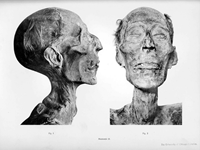Supernova remnant 3C 58 contains at its centre a rotating neutron star known as a pulsar. By studying this neutron star and others like it, astronomers have revealed that the interiors of neutron stars may contain a type of ultra-dense matter found nowhere else in the Universe!
Rings and swirls of material in shades of blue and purple extend in many directions from the neutron star, resembling the shape and arms of an octopus.
Surrounding the octopus-like structure is a cloud of material in shades of red that is wider horizontally than vertically. A strip of purple material extends towards the left edge of the red cloud and eventually curves upwards. Another purple stripe extends towards the right edge of the red cloud, but is less pronounced than on the other side. Stars of many shapes and sizes fill the entire image.
Supernova remnant 3C 58 contains at its centre a rotating neutron star known as PSR J0205+6449. Astronomers have studied this neutron star and others like it to investigate the nature of the matter inside these very dense objects. A new study using NASA's Chandra X-ray Observatory and ESA's XMM-Newton reveals that the interiors of neutron stars may contain a type of ultra-dense matter found nowhere else in the Universe.
In this image of 3C 58, low-energy X-rays are shown in red, medium-energy X-rays in green and the high-energy X-ray band in blue. The X-ray data is combined with the yellow optical image from the Digitised Sky Survey. The Chandra data show that the rapidly rotating neutron star (also known as a ‘pulsar’) at the centre is surrounded by a torus of X-ray emission and a jet extending several light-years across. Optical data show stars in the field.
The team in this new study analysed previously published data from neutron stars to determine what is called the equation of state. This refers to the basic properties of neutron stars, including pressures and temperatures in different parts of their interiors.
The authors used machine learning, a type of artificial intelligence, to compare the data with different equations of state. Their results imply that a significant fraction of the equations of state - those that do not include the ability for rapid cooling at higher masses - can be ignored.
The researchers took advantage of the fact that some of the neutron stars in the study are located in supernova remnants, including 3C 58. Since astronomers have age estimates of supernova remnants, they also have the ages of the neutron stars formed during the explosions that created both the remnants and the neutron stars. The astronomers found that the neutron star in 3C 58 and two other neutron stars are much cooler than the other neutron stars in the study.
The team thinks that part of the explanation for the rapid cooling is that these neutron stars are more massive than most others. Since more massive neutron stars have more particles, special processes may have been triggered that cause neutron stars to cool faster.
One possibility for what is happening inside these neutron stars is some kind of radioactive decay near their centres, where neutrinos (low-mass particles that move easily through matter) carry most of the energy and heat, causing rapid cooling.
Another possibility is the presence of exotic types of matter in the centres of faster-cooling neutron stars.
Image Description:
This is an image of the remnant of an exploded star called 3C 58, shown in X-ray and optical light. At the centre of the remnant is a rapidly rotating neutron star called a pulsar, which shows itself as a somewhat elongated bright white object.


 Nielawore
Nielawore









Yorum yazmak için lütfen giriş yapınız